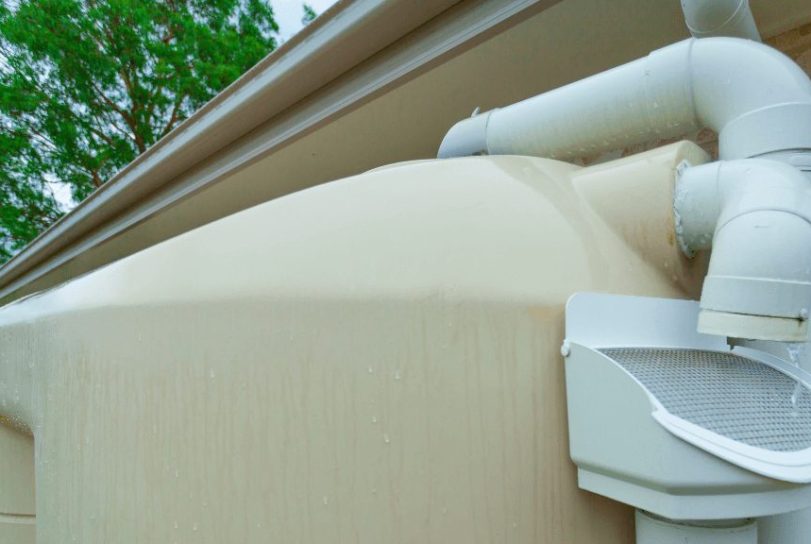A rainwater tank installation involves a plumber installing the tank in a property and connecting it to all the right systems and parts. The installation of the rainwater tank should consider all standards and regulations, be planned out previously and carried out by a licensed plumber. Here at The Local Plumber our emergency plumber team are here for all Melbourne locals to perform professional rainwater tank installation services.
A rainwater tank installation involves planning out the location of the tank, that it follows all standards and regulations and that it is the correct type. It is important that the system is in the right location, it can connect perfectly with other systems and will offer adequate services to the home. A qualified plumber is needed to perform the rainwater tank installation as there are many plumbing components and connections involved.
Rainwater Tank Installation Checklist
Below is a guide on all the different considerations when it comes to rainwater tank installations:
Melbourne Regulations and Standards
Rainwater tanks will have a maximum storage capacity of 10,000L and these will most times not need council approval. There are conditions that will need to be met however which can be found through Melbourne Water’s Rainwater guide. When the rainwater tank will be connected to the toilet, washing machine or other plumbing systems then there will be a checklist of tasks to ensure that it can go through, including:
- An inspection and assessment of the site where the rainwater tank will be installed
- The backflow prevention systems will be checked to ensure they are up to standard and work within the property
- Applying to connect the systems at Melbourne Water.
Contact your local council if there are any local standards and requirements that need to be met with the rainwater tank.
Where Should I Place My Rainwater Tank?
The location in which the rainwater tank will be installed will need to be checked to make sure it will function safely and properly. This is to ensure that the tank’s catchment area will be maximised, to lower the plumbing and connection costs and to have a stable and safe foundation for the rainwater tank to be on. Specific areas and sites will have certain site-specific considerations and checking the tank can be safely installed in the desired location is important.
A plumber will be able to inspect the location and provide professional advice on whether or not the rainwater tank can be installed there. It is also important to know that the rainwater tank cannot be placed over water mains or wastewater mains. This is because the water tank, especially when it is full, is extremely heavy and can cause serious damage to the mains.
How To Choose The Correct Rainwater Tank?
There are many factors to consider to ensure that the right rainwater tank is installed:
- Type – there are many different types of rainwater tanks that vary in colour, shape and size. Choosing the right rainwater tank is important to make sure it is perfect for the home. There is also the option of a below-ground tank but these are more expensive, require additional backflow prevention measures and might not be able to be installed in certain positions.
- Size – the tank should be suited to the home’s needs, a plumber or professional will provide good advice on the right tank size. The budget should also be considered, how much space is allocated for the water tank and the fact a concrete foundation is included.
- Pump – rainwater tanks will most times need a pump that is used to supply the water at the same pressure as the drinking water supply. The pumps can be external that sit on the ground or they can be submersible that are inside the tank. External pumps are more durable and have a longer lifespan while submersible pumps are quieter and take up less space.
- Location – when deciding on what tank to use it is important to consider if the downpipes and stormwater pipes can be easily connected to it.
Installation Add-ons
The rainwater tank installation itself has many considerations, such as other accessories, parts and systems to enhance the rainwater tank’s usage, some including:
- The roof and gutter should be able to properly collect the rainwater
- Ensure to regularly clean out the blocked gutters and downpipes to prevent blockages which can also be done by installing downpipe screens and gutter guards
- Make sure that animals and insects cannot enter the rainwater tank
- A first-flush device should be installed which will help with allowing only the cleanest water to enter the tank
- A fail-safe, auto-switching device or a top-up water connection should be installed as they will supply drinking water if the tank is empty
- Install a pressure tank that connects to the pump which will reduce the rate the pump runs which saves energy
Rainwater Tank Installation Process
It is important that a qualified plumber performs the rainwater tank installation as they will be experienced and will know how to professionally install each part and system. There are also many plumbing connections involved that a plumber will be able to correctly work with, including the downpipes to the tank, the tank to the stormwater system, the tank to the pump and the pump to all connections such as the hose, toilet and washing machine.
Melbourne Rainwater Tank Installation Services
The Local Plumber offers the best rainwater tank installation services to all of Melbourne. Our plumbers are experienced at working with rainwater tanks of all kinds and will professionally plan out and install the system. Our blocked drain services are here as well for us to clear any blockage, including gutter and downpipe ones. For the best rainwater tank installation services – always rely on The Local Plumber Melbourne.

